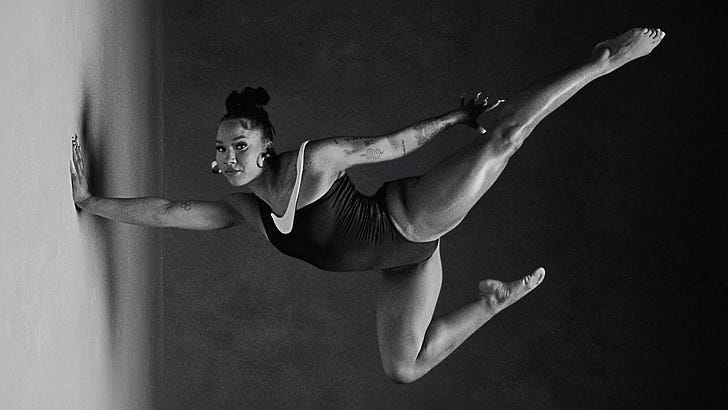The Deeper Meaning of the Super Bowl Halftime Show 2025 & Kendrick Lamar's Bold Move
And it's nothing about Drake...
I’m gonna start with an honest admission. I don’t watch the Super Bowl. The day after the Super Bowl, I heard something about this great ad for the Super Bowl and so I watched it on YouTube.
I was excited to see how women athletes were being highlighted, especially Black women athletes, and I loved Serena’s dance. I thought the whole thing was pretty cool and even made some comments on Instagram about it, not realizing how much I was missing! I was so focused on the cool story about Serena and the history of her crip dance during the 2012 Olympics that I didn’t even SEE the entire halftime show.
Whoa. Was I ever seeing the trees and not the HUGE forest that was actually in front of me!
Then today I watched the actual half-time show. I’ve been hearing Kendrick Lamar’s Not Like Us on repeat on Instagram so much that I was starting to scroll past as soon as it started playing because it is completely blowing up on Instagram and getting annoying. Here it is if you want to watch the full show (best 13:25 you’ll ever see), here is the link but don’t watch it NOW, read the article first, then watch it!
But wow. Keeeennnndrrriiiicck. OK, we are talking DEEP here. This was a STATEMENT. And I went deep down a rabbit hole this morning to see just how deep this would go. Pretty sure I’ve only scratched the surface here, but I’m gonna talk about it anyways so feel free to dig deeper!
So I watched the show and then decided to use ChatGPT to help me fill in the blanks. I am a white clueless American who is not into sports or hip-hop, so you need to start from the beginning for me!
Here is what ChatGPT said… (I will share it as a PDF link if you want to download it. It’s pretty freaking cool!)
Kendrick Lamar’s 2025 Super Bowl Halftime Show - A Deep Symbolic Breakdown
Kendrick Lamar’s Super Bowl performance wasn’t just a rap concert—it was a meticulously crafted cultural statement, full of symbolism addressing race, identity, power, and the music industry. Here's a breakdown of the most powerful themes:
1. Opening Scene: Samuel L. Jackson as "Uncle Sam"
💡 Symbolism: Government control, racial oppression, and the illusion of freedom.
Samuel L. Jackson opened the performance dressed as Uncle Sam, the iconic representation of the U.S. government. This was a clear reference to Kendrick’s 2015 song “For Sale?”, where he criticizes how the American system exploits Black artists and communities.
The visual of Jackson pointing at the camera mirrored the classic “I Want You” U.S. Army poster, making a statement about the government’s role in shaping narratives about Black identity.
2. “HUMBLE ”– The Divided American Flag
💡 Symbolism: American hypocrisy, systemic inequality, and media manipulation.
As Kendrick performed “HUMBLE.,” his dancers formed an American flag—
split down the middle.
This likely referenced: Colin Kaepernick’s national anthem protests and the ongoing racial justice conversation.
How Black artists are celebrated but not always respected by mainstream America.The division within the country—especially regarding race and class.
3. “DNA” – Pride vs. Stereotyping
💡 Symbolism: Black heritage, strength, and the duality of how Black identity is portrayed in America.
The song’s lyrics contrast pride in Black identity with how society often stereotypes Black men.
The lighting shifted between red and blue, symbolizing gang culture but
also political division (Republican vs. Democrat).
This moment reflected Kendrick’s core message in "DNA."—society labels
Black men as threats, but their heritage is powerful and undeniable.
4. “Not Like Us” the System – West Coast Pride and Breaking
💡 Symbolism: West Coast unity, dismantling industry politics, and challenging gatekeepers.
This song was technically a diss track against Drake, but its significance went beyond just personal beef.
Musically, it was a celebration of West Coast hip-hop—using a beat reminiscent of the 90s West Coast sound.
The red bandanas in the choreography referenced both gang culture and
unity, implying that Kendrick is about bringing people together rather
than fueling division.
The crowd chanting the lyrics in unison felt like a moment of collective
resistance—almost as if Kendrick was leading a cultural revolution
through music.
5. Serena Williams’ Dance – Reclaiming Black Joy
💡 Symbolism: Redemption, challenging stereotypes, and rewriting history.
As we discussed earlier, Serena Williams performing the Crip Walk was about reclaiming a moment from her past when she was unfairly criticized for celebrating her gold medal at the 2012 Olympics.
This move wasn’t just about her—it was a statement about how Black joy
is often scrutinized or labeled “ghetto” when it’s simply an expression
of culture.
Her appearance added a layer of historical and cultural redemption to
the performance.
6. “Luther” and “All the Stars” – Hope and Legacy
💡 Symbolism: Honoring historical leaders, envisioning a better future.
“Luther” likely referenced Martin Luther King Jr., connecting Kendrick’s music to Black activism and the civil rights struggle.
“All the Stars” (his song with SZA) was performed as a closing
statement, representing hope, success, and the next generation of Black
leaders.
The backdrop of stars in the visuals suggested that Kendrick sees his
legacy as one that inspires future Black artists, athletes, and
thinkers.
Final Takeaway: Kendrick’s Super Bowl Performance as a Cultural Milestone
Kendrick Lamar didn’t just rap at the Super Bowl. He used the biggest stage in America to tell a story about identity, struggle, and triumph.
He called out the system.
He celebrated Black excellence.
He reclaimed moments that were once criticized.
He made it clear that hip-hop isn’t just entertainment—it’s a powerful
vehicle for social change.
This wasn’t just a halftime show—it was a statement.



